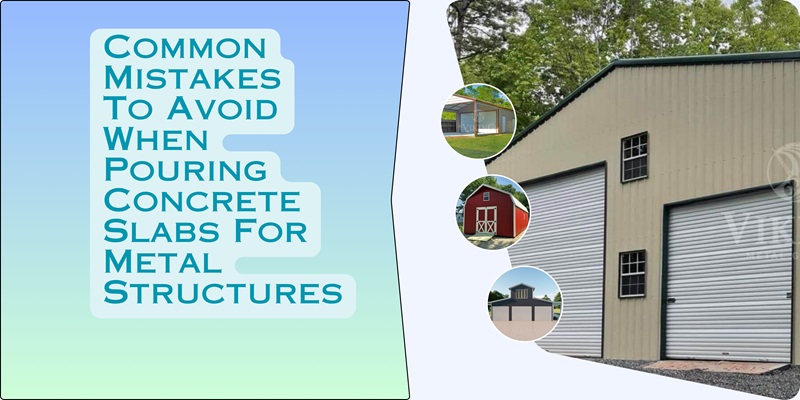Common Mistakes to Avoid When Pouring Concrete Slabs for Metal Structures
Are you looking to buy steel structures but unsure what goes into pouring a concrete slab? That’s okay. Many people think getting a base ready for their steel structures will save them time and money, but there is more than one step in laying a base. What are they, and how do they all work out? Let’s find out one by one.
Safety Precaution If You DIY Concrete Base for Steel Structures
Personal Protection Equipments (PPE)
There is specific equipment that you need for your personal safety and security. They are – construction helmets, protective eyewear, gloves, sturdy boots, earplugs, and dust masks.
Guidelines
You must read all instructions carefully when doing any construction work yourself. You may have to lift heavy materials, so staying hydrated while working in hot weather is best. Avoid stepping on wet concrete as it can be slippery, and you won’t want to ruin your hard work. It is best to keep the working area organized to avoid any accidents.
Common Mistakes to Avoid When Pouring Concrete Slabs for Metal Structures
Not Prepping Site
To prepare the site for the concrete slab, you must clean all debris from the site. You can remove any plantation, rocks, boulders, and vegetation. The dig area should be filled with gravel, sand, and crushed stone for better drainage.
Afterward, you can level the area for placing forming and reinforcement rods.
Not Comply with Building Codes
The rules and guidelines are based on location region by your local authorities. For instance, all concrete slabs in Texas must be placed monolithically with a minimum thickness of 4 inches. The slab’s top (placed on a grade foundation) must be at least 6 inches above soil level.
Not Having Proper Concrete Mix
Preparing concrete mix is a crucial task. The concrete may become too brittle and develop cracks if mixed in the wrong proportion. In addition, concrete mix must be of high quality.
- Too wet concrete can be sloppy and won’t maintain the structure.
- Too dry concrete won’t help create a smooth, wet, and muddy surface to use a trowel over it. They may leave behind small air pockets that can lead to cracks in the future.
- The general standard for concrete mix is 1 part cement, 2 part sand, and 4 part aggregates.
Using Old Cement
Usually, the life of a cement is half a year. It can vary depending on its quality and where it is stored. Cement generally loses its strength when it comes in contact with the moisture from the air. A cement left out there for more than 3 months has more than 20% reduction in strength. When used in the concrete mixture, this cement will not gain the desired strength.
Since you have to leave concrete for at least four weeks to cure anyway, you can buy steel structures before laying the foundation, as shipping usually takes weeks, depending upon the complexity of the steel structures.
Not Having Reinforcement Rods
A reinforcement rod’s job is to boost concrete’s tensile strength. This resists the development of cracking or breaking in the future. So, their absence makes no sense at all. After all, a solid base is where steel structures stand. But concrete is moist, and we all know moisture can ruin bare steel, causing it to rust. So, what to do?
Simply use a reinforcement coated with epoxy resin, galvanized, or fiberglass rebar for ground-level work. They will resist rusting and provide structural support to steel.
Thinking Reinforcement Rods Is Enough to Prevent Cracking
You can use fiber-reinforced concrete (FRC) to strengthen the concrete further. It has fiber of materials such as steel, glass, synthetic, or natural fiber mixture to it. These are short fibers evenly distributed in random directions. You can pick the percentage of fiber used along with its size.
Note that reinforcement rods won’t stop cracking inevitably. So, lay the reinforcement rods in a grid pattern to reduce the chances of cracking. Within a few hours of pouring concrete, you can use a masonry saw to make cuts in a large grid pattern. It helps control the random cracking. No matter how robust steel structures are, a weak foundation won’t add to their longevity.
Inaccurate Forming
Forming is a frame or layout the concrete takes while still curing. Think of it as a cake mold that defines the shape of a cake while the batter is still wet. If the forming is weak or inaccurate, it may lead to a disproportionate slab. So, thoroughly check to see if the forming is precisely laid on the site.
If it breaks during concrete pouring, it will create a lot of waste. You can use wood or braces to create form.
Improper Pouring
A concrete pad needs to be thick enough to gain strength. Pour it too thin, and it will break with the first pressure impact on it. That’s why it is recommended to get a concrete pad of at least 4 inches thick. You can increase the thickness from 6 to 8 inches to hold extra weight.
- Unfavorable weather: While pouring concrete, the temperature must also be taken into account. The best temperature to pour concrete slab is between 50 to 60 ℉.Temperatures above 80 or more can cause hardening sooner, and temperatures below 30 or lower can lead to frost development.
- Bare hands: While pouring concrete, refrain from using your bare hands. Always wear gloves, as concrete is highly alkaline, and your skin may get an allergic reactionfrom it.
Watch Those Surface & Edges
To smoothen out the concrete, you will need to use a trowel over the poured concrete as soon as it dries out yet have a little softness to it.
- Using a trowel to smoothen out the surface while the concrete is wet will create a water form on top, leading to a break or crack in the future.
- If you use a trowel to smoothen out the surface while the concrete is dried out, you won’t get the desired smooth surface.
Timing is important here. Unfortunately, there is no fixed time, as temperature and humidity are crucial. Ensure that the edges are smoothen out as well.
Insufficient Curing Time
The last part is to let the concrete mixture cure. This is a process of hardening the concrete. In most cases, water is poured on a concrete slab for a week to maintain its strength. You can also use membrane curing for colder regions and smaller areas. In general, it takes around four weeks to get completely cured.
In The End
We can say that prepping up the foundation for steel structures is an important task. You must do it carefully and with the correct measurements. Failure to follow any technique or missing any step may waste time, effort, and money. If you have no prior experience, it is best to leave it to professionals.
When you buy steel structures, you can ask your metal building dealer for a contractor to help you prepare the base. They will be happy to help you. Some dealers even provide the foundation as a part of their package. So don’t forget to ask about it.



